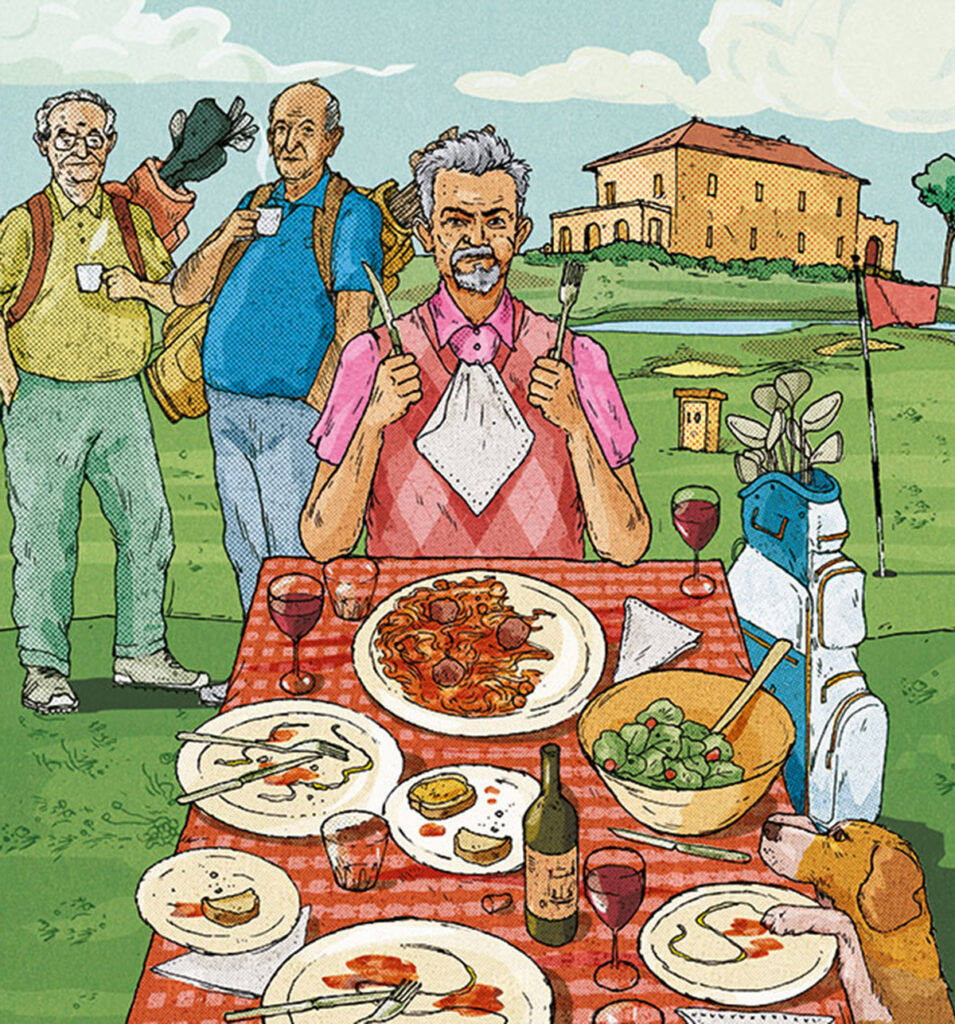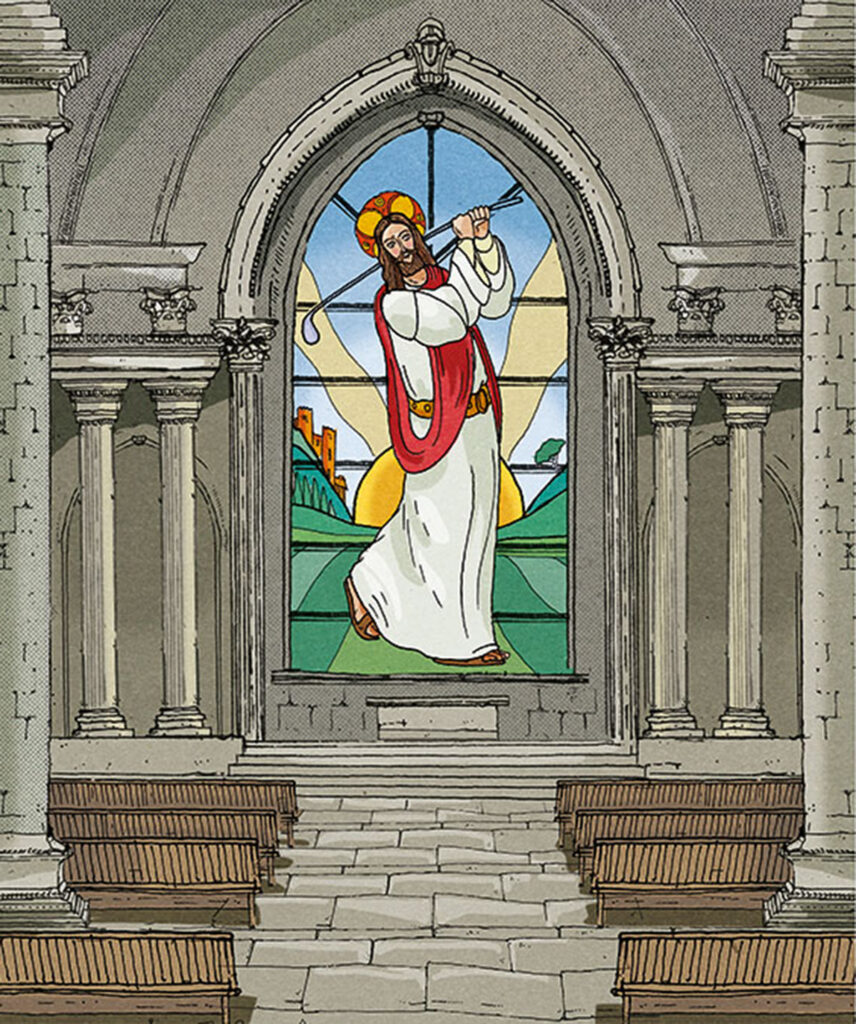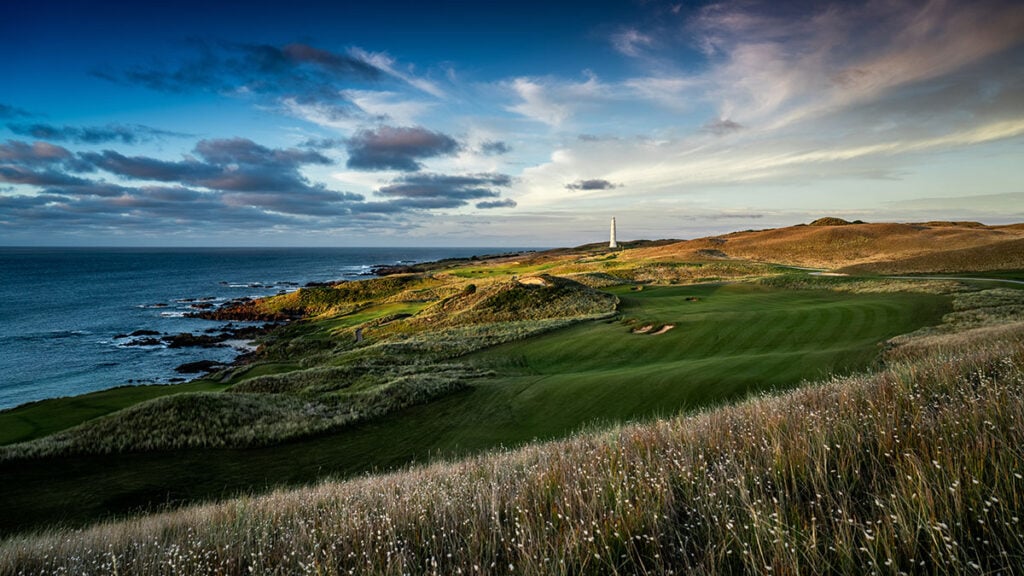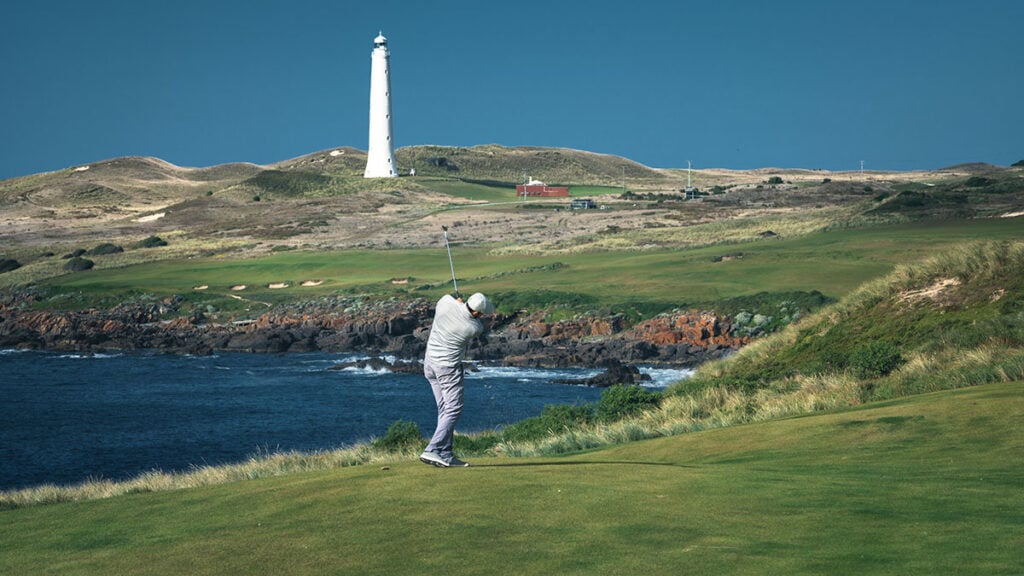For more than two decades, our writer has enjoyed a love affair with golf in the land of Michelangelo.
recently had the opportunity to play the newly redesigned course where the 2023 Ryder Cup will be played – Marco Simone Golf & Country Club on the outskirts of Rome. Twenty-two years earlier almost to the day, I had enjoyed an older version of Marco Simone on an assignment to write about The Eternal City’s golf and eating options. That trip introduced me to golf Italian-style, and a dozen times over the past two decades I’ve made month-long visits to the land of my father’s ancestors, playing courses from the sunny southern coast of Sicily to the Alpine hills on the Swiss border.
In most ways, golf in Italy is like golf elsewhere, with certain delectable differences. I’ve played three rounds at an elegant course called Olgiata, 45 minutes north of Rome. On one of those occasions, I joined a couple of 60-somethings, avid golfers and club members who were enjoying their early retirement. As we putted out on the ninth, they asked if I wanted to stop for a bite before playing the back. I assumed, as most foreigners would, that they meant a quick panini and a bottle of cold Peroni. Instead, we were seated at cloth-covered patio tables and served a meal of salad, pasta, wine, espresso and a slice of torta before staggering off to the 10th tee.
Aside from the food at the turn and a few other small quirks (dogs are often welcome on Italian courses. I once played a round with a couple on a course up north, and they walked a small dog on a leash from first tee to final green), the universal language of golf is evident in the bel paese. Even the vocabulary will be familiar to English-speaking visitors: rough, green, putt, fairway, driver, birdie, par and bogey are all cognates. Double-bogey is doppia bogey, and “woods” and “irons” go by their Italian names: legno and ferro. Hole is buca, tee is partenza and a tee-time is an appuntamento, but English will likely be spoken wherever you play.
Italy’s golf history is scant compared to that of the British Isles, but the game has been played around Rome since at least the first decade of the 20th century. British diplomats, posted to the Italian capital and missing their home links, were known to knock a ball around the Borghese Gardens. Eventually, they built courses on Italian soil, and the game took root and slowly sprouted. Since the Italian Open debuted in 1925, it has been won by the likes of Peter Alliss, Billy Casper, Greg Norman and David Feherty, and Italy has produced top-ranked players like Costantino Rocca, 2018 Open champion Francesco Molinari, Matteo Manassero – the youngest player ever to win a European Tour event – and Silvia Cavalleri, a winner on the LPGA Tour. More recently, Benedetta Moresco was the low amateur at the US Women’s Open at Pebble Beach in July.
Visitors searching for golf in Italy will find everything from shabby tracks carved out of flat, featureless fields to classy country clubs with Maseratis and Ferraris in the carpark, fellow golfers skilled and unskilled, fast and slow, considerate and not-so-considerate – in other words, about what they would find at home. One nice difference: a foreign golfer with a handicap of, say, 10, will be considered an impressive player in most Italian circles.

Italy’s richer north boasts a larger share of courses: the mountain-goat Menaggio and Cadenabbia near Lake Como, where George Clooney likes to play; Parco Regionale la Mandria on the grounds of the former hunting estate of the Royal House of Savoy near Turin, where the Molinari brothers honed their skills; Golf Club Garlenda north of Genoa, and Rapallo Golf & Tennis south of that city; and humbler old classics like Villa d’Este and Monticello near Milan.
A new addition to this list is the picturesque Robert Trent Jones Jnr design Antognolla, recently voted the best course in Italy. Set in a gorgeous green bowl surrounded by steep Umbrian hills not far from Perugia, Antognolla has an abundance of doglegs, superb greens, wonderful views, world-class service and plenty of challenge. Try to ignore the 12th-century castle looking over it all as you navigate the No.1 index hole, the 455-yard, par-4 16th, and be sure to have dinner at nearby Il Caldaro and ask for the local white wine, L’Affabile.
In the poorer south, golf is harder to come by, though Acaya near the Apulian city of Lecce is a wonderful flat, watery track. Verdura in Sicily is first-rate, and Sardinia’s Pevero Golf Club fits in well with the Costa Smeralda yachting crowd.
None of those, however, provide the post-round fascination of the courses in and around Rome: Marco Simone, Castelgandolfo, Acquasanta, Parco de Medici, Olgiata and Federazione Italiana Golf (Italy’s equivalent of Sandy Golf Links) a bit farther afield.
The American writer Anatole Broyard once said, “Rome was a poem, pressed into service as a city,” and as every visitor soon realises, walking the lanes and alleys of that city feels like strolling through human history. Even littered streets and hordes of summer tourists can’t spoil the glories of Rome. During our many visits, my wife, Amanda, and I have spent enough hours at the Sistine Chapel, the Colosseum, Castel Sant’ Angelo, Trevi Fountain and the Forum to have fallen into the habit of seeking out less well known spots for our Roman excursions, food and lodging.
Our first meal on this recent trip was at an unpretentious trattoria called der Pallaro, which is set in an alley a few blocks from Campo di Fiori. Paola Fazi has been cooking or presiding there since decades before our first visit, in 1991. There is no menu. You sit down, and the food arrives, always the same: a delightful dish of stewed lentils accompanied by buffalo mozzarella, fennel, olives, arancini and prosciutto. Next come two types of perfectly al dente pasta in a bowl, one in a cacio cheese sauce, the other marinara. Then a meat dish with cooked spinach and homemade potato chips, followed by a slice of that day’s custard cake. The wine list has two choices, red or white, and you pour your own from a squat, unlabelled pitcher, with free refills.
After having managed to digest that feast, the next day we hit another favourite, this one in Trastevere, the formerly working-class but newly hip southern section of the city. Il Miraggio is off the beaten track enough to escape Trastevere’s tourist crush, and the food is close to perfect (try the spaghetti alla mediterranea with a side of cannellini beans in a garlicky tomato sauce) and, given the location, ridiculously reasonable.
On this visit, we eschewed Rome’s better known chain hotels, too, in favour of an unusual lodging, The Hotel Scalinata di Spagna, staying for a couple of nights in its semi-subterranean apartment aside the Spanish Steps, a place with 18-foot ceilings, a winding marble staircase, an opera singer serenading a crowd below our windows and a cool jazz club close by, on Via Gregoriana. One evening we bought roasted chestnuts from a sidewalk vendor and made a passeggiata along the cobbled streets of Rome’s ancient centre, eventually ending up near the Piazza del Popolo for a glass of wine and a bowl of vegetable soup at Caffe’ Rosati. It’s a pricey, touristy section of the city, a neighborhood where you can grab a $6,000 Brioni suit or a $5,000 Dolce and Gabbana purse for a friend mired at home, or step into an ancient church for a moment of quiet contemplation.
To be closer to Marco Simone, we moved out to Tivoli for several nights. Tivoli is a marvelous small hill city, with the famous Villa d’Este available for a tour, and shops, eateries, churches and piazzas in abundance. Residenze Gregoriane offered a marble-sided, candlelit basement pool that made us wonder if some kind of toga festival was about to occur. The Residenze has the friendliest owner and staff on Earth, all English-speakers, who bring you breakfasts in a courtyard, the walls of which are covered with 500-year-old mosaics.
Practising my Italian there after a delicious tuna steak at nearby Il Ciocco, I discovered that Filippo Grasso, one of the servers, had been a passionate golfer in his youth and had spent several years working at Marco Simone. “You’re in the fresh air,” he said, waxing poetic about what he called his passione, his face lit by a glow all golf lovers would understand, “your feet are upon the Earth. You cannot think of anything else, any worries, any troubles. You meet wonderful people.”
He confessed to not having played Marco Simone since it was re-routed in 2021 by European Golf Design in co-operation with Tom Fazio II (whose father, Jim, with David Mezzacane drew up the original), and so we made the easy 40-minute drive from Tivoli, curious about what we would find.
A note here on the Italian roads, and I say this as a former Boston cab driver: the “easy” in the previous sentence is relative. I’ve driven probably 25,000 miles in Italy, and renting a car has enabled my family and me to see places even the country’s expansive train system couldn’t show us. However, my recommendation would be, unless you are a very skilled and fearless driver, one who understands Italian road signs, is fluent with a ‘stick shift’, doesn’t mind being tailgated at every opportunity at speeds between 20 and 120, can navigate instructions at the gated toll booths, and can handle a vehicular urban circus in which Vespas and motorcycles are constantly zipping past your door handles, you might want to hire a car and driver. That way, you can watch the circus and perhaps even enjoy it.
One example should suffice. Years ago, Amanda and I were riding a bus north from the city of Trento, on our way to a mountain hideaway in the Dolomites. I was sitting in the rear left part of the bus, next to a window. As we climbed a steep road, one lane of traffic in each direction, I noticed a Mercedes swing out behind us into the opposite lane, intent on passing. This wouldn’t have been particularly unusual, despite the solid, no-passing line, but then a small Fiat appeared, in the far breakdown lane, going uphill, the wrong way, with a thousand-foot dropoff on the far side of the guard rail to the driver’s left. The Mercedes passed the bus, then the Fiat angled in and passed the Mercedes, and just in time, too, as a fully loaded logging truck came thundering along in the downhill lane, shaking the bus windows as it passed. If that’s your idea of fun, go ahead and reserve a rental car for your Ryder Cup visit.
Fans heading over to watch the matches won’t get to play Marco Simone, so, stepping onto the first tee and perusing the beautifully groomed opening par 4, I felt a particular thrill.

That thrill, I’m sorry to say, didn’t last. Marco Simone has some of the more interesting green complexes I’ve seen, but the combination of hard, slick putting surfaces and multiple, severe undulations didn’t seem quite reasonable. The approaches often require blind shots to these greens, and, though the holes offer some variety, until the home stretch I didn’t encounter one that felt particularly rich in character. Complicating matters is the surrounding territory, marked everywhere by high-tension wires and towers, the land mostly dry and flat, with only Mount Sant’ Angelo Romano to the north enlivening the scenery. Not until I reached the interesting 16th, with its risk/reward downhill tee shot to a green protected by a creek and several of the course’s numerous bunkers, did I begin to appreciate the vast amount of work and skill that has gone into the new design. The wonderful par-3 17th, surrounded on three sides by deep fescue, and the downhill-curling 18th, its mounded fairway dropping towards a green guarded by a small pond, helped me revise my opinion upward.
As I played, with Amanda along for the ride, we watched a team of workers planting small red flags in the fairways, marking lines, we were told, where the rough and fescue would be brought closer in to narrow the landing areas considerably. We were also told that not a single hole remained from the original design. Because putting is so often the determining factor in Ryder Cup play and because the new greens are so treacherous, the competition will probably elicit excitement among the fans and complaints from the participants. The numerous elevation changes will offer an abundance of perfect spots from which to view the action.
Somewhat underwhelmed by the visit to Marco Simone (although we had caught a glimpse of the cup itself being carried in for a televised event), I sought comfort two days later in an old friend, Circolo del Golf Roma Acquasanta, Italy’s oldest golf course (1903), and one that sits within Rome’s municipal borders.
If Marco Simone shouted “New!” at every step, Acquasanta, laid out by British diplomats, said “Old” quietly and proudly. Golfers will find numerous elevation changes, but the hundreds of maritime pines and cedars lining the broad fairways give the property the feel of an ancient imperial villa. The greens were absolutely perfect, quick and true, and held approach shots – mine, at least – much better than the newer, harder surfaces at Marco Simone.
Acquasanta has hosted three Italian Opens, but it’s now too short for major tournaments, topping out at about 6,500 yards. Eminently playable, gorgeous to look at, with occasional glimpses of nearby Roman aqueducts, some 400-yard-plus par 4s, and a devilish creek that comes into play on half a dozen holes, the course is quietly elegant and sufficiently challenging. As a bonus, three miles farther along Appia Nuova, just past the Capannelle horse racing course, stands a famous old restaurant called Salvi with plenty of parking (which, in and around Rome, is rare as a gold strike), superb pizzas, pastas and grilled meats, an extensive wine list and staff that serve with grace and aplomb.
To add a dose of sugar to my Roman golf espresso, and because several of Marco Simone’s critics suggested it, I made a return visit to the redone Olgiata Golf Club on the city’s northern fringe. I played that day with an intrepid high school classmate (“intrepid” because we walked the first five holes in steady rain – Rome’s only rainy day in the previous three months – with a few minutes of lingering thunder). Housed in a gated community that requires you to make a tee-time before attempting a visit, its sinuous but spacious fairways are lined with willows, pines, poplars and palm trees and spotted with ingeniously positioned bunkers and several water hazards (many of the water hazards on Italian courses have orange life preservers hung on nearby posts, in case a non-swimmer happens to topple in). Olgiata is a comfortable walk with six sets of tees ranging to 7,200 yards. We both preferred the front nine to the back, which had several blind shots, but there is a gracefulness to the new design that made the course feel like a mix of the best features of Marco Simone and Acquasanta. There are also reported to be Etruscan tunnels running beneath every hole.
Having grown up with an Italian last name, in an Italian-American enclave hard against Boston’s northern border, and then having left for fancy schools and higher socio-economic altitudes, I’m all too familiar with the slurs and assumptions some Americans still make and hold at Italians’ expense. The old prejudices and stereotypes have not yet quite expired. Driving through Kansas in 2020, I saw a sidewalk placard advertising a pizza place by using an olive-skinned dude in a felt hat, his face surrounded by fake bullet holes. The “dese and dose” comments (Italian has no ‘th’ sound, so immigrants to America had trouble pronouncing it), the organised-crime association made worse by “The Godfather” films and “The Sopranos”, I have to say it’s a touchy area for some of us.
I counter those offences by travelling to Italy whenever I can. Great food, si. Half the world’s art treasures, si. Incredible churches (like Santa Maria in Trastevere – which has a must-see mosaic of Jesus standing beside his mother with an arm draped around her shoulders) si, certo. But less well known is the grace and generosity apparent in the way many Italians interact with each other, and even, despite the avalanche of tourists, with visitors. Countless times, walking in cities both south and north, we’ve asked directions only to have the locals decide to walk with us – in one case for 20 minutes – to make sure we found our destination. When my friend and I arrived hungry and a few minutes late for our tee-time at Olgiata, Andrea Trottini was minding the desk there and encouraged us to have a leisurely snack at the bar before teeing off.
This graciousness often extends to the course, where impromptu match-ups segue into real conversations, mid-round meals, and, occasionally, as happened to me at Rome’s working-class course, Fioranello, an invitation to meet fellow players for drinks on an upcoming weekend night.
Italy cannot compare to Ireland and the United Kingdom in terms of the number and quality of golf options, but it has enough good courses to fill a vacation itinerary, and with its food, wine, art and hospitality, the land of Michelangelo and Manassero, Caravaggio and Cavalleri might very well offer the travelling golfer full compensation for making the long trip to get there.
Illustrations by Wesley Merritt



